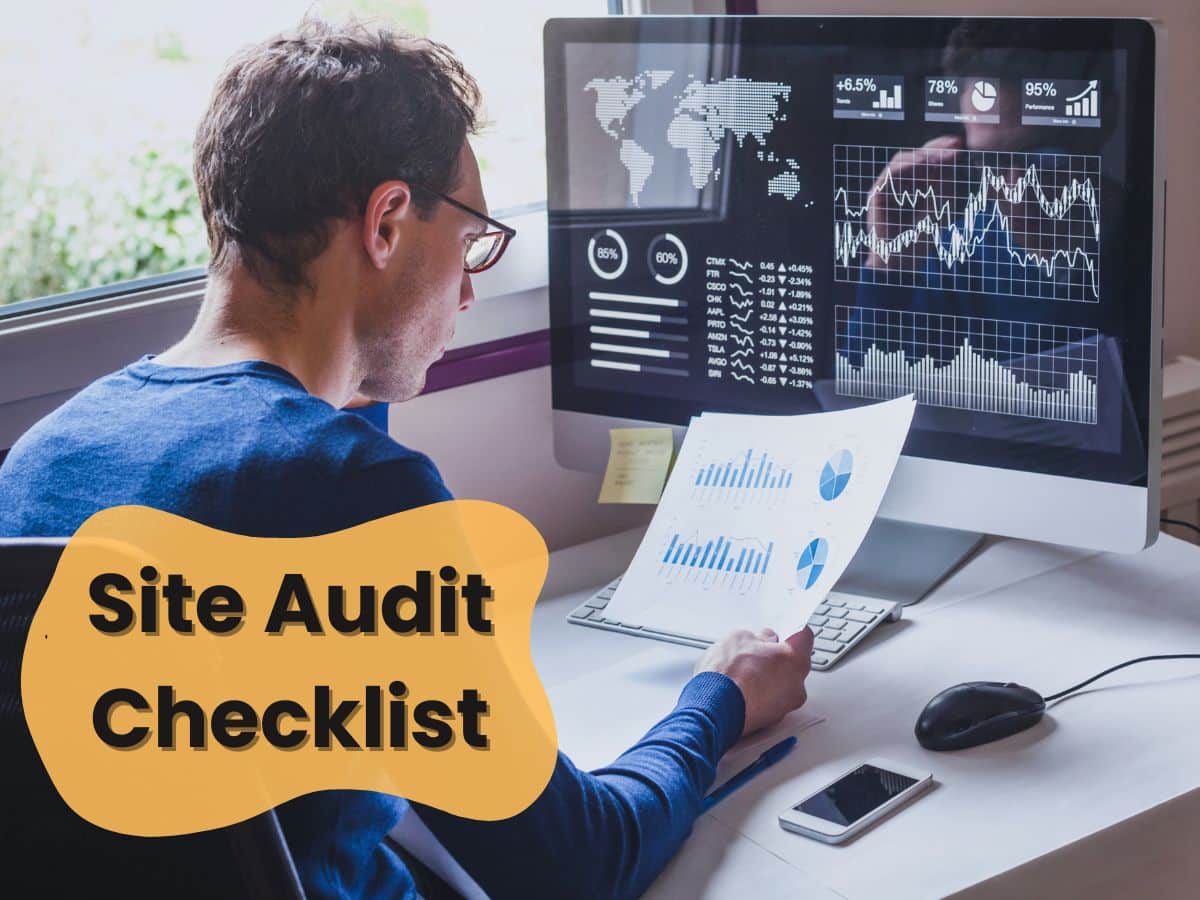
What Is YouTube SEO? 2024 YouTube SEO Checklist
In today’s fast-paced digital world, video content has become a crucial me [...]

A Site Audit is a comprehensive analysis of a website’s performance in relation to search engine optimization (SEO), user experience, and technical performance. It helps identify areas where a website may be underperforming and provides insights into how to improve rankings, usability, and overall performance.
Table of Contents
A well-conducted site audit can uncover issues like broken links, slow-loading pages, poor mobile optimization, and thin content that might be impacting your search engine rankings. This is especially crucial for startups and small businesses, as a solid online presence can be the difference between growth and stagnation.
According to research, 61% of marketers say improving SEO and growing their organic presence is their top inbound marketing priority.
This highlights why an SEO-focused site audit is vital for businesses aiming to strengthen their digital footprint.
A thorough site audit requires looking at multiple aspects of your website. Below is a step-by-step guide on how to perform one effectively:
Start by examining your website’s overall structure. A clean, intuitive structure ensures that both users and search engines can easily navigate through your pages. Use tools like Google Search Console SEO audit to spot issues such as broken links or missing pages. This tool also helps identify indexing issues that might prevent your pages from appearing in search results.
Audit site speed by using tools like Google’s PageSpeed Insights or GTmetrix. If your pages take longer than 3 seconds to load, you may be losing visitors.
Studies show that 53% of mobile users leave a page if it takes longer than 3 seconds to load
With over 50% of global web traffic coming from mobile devices, optimizing your website for mobile is crucial. Google’s mobile-first indexing prioritizes the mobile version of your site for ranking purposes. Make sure your website is responsive and provides a seamless experience across all devices.
Ensure that each page on your site is optimized for relevant keywords. Titles, meta descriptions, and headers should all include relevant terms like site audit checklist. Also, check for any duplicate content issues, as they can harm your rankings. Screaming Frog is a good tool to measure on-page important factors.
Content is king in SEO. Make sure the content on your site is relevant, up-to-date, and provides value to your audience. Thin or outdated content can lead to lower engagement and rankings. Include content audits in your site audit process to identify underperforming pages.
Lastly, assess your site’s backlink profile. Backlinks from reputable sources signal to search engines that your site is reliable. However, toxic or spammy backlinks can harm your SEO. Tools like Ahrefs or Moz can help you analyze your backlink history.
A comprehensive site audit is essential for any business looking to improve its online presence and performance. Whether you’re running a startup or managing an established business, auditing your website ensures you are not missing key opportunities to optimize for SEO and user experience. Here’s an 18-step site audit checklist that covers every important aspect of your site:
Start by crawling your entire website to discover any underlying issues like broken links or orphan pages (pages that aren’t linked to other pages). Use tools like Screaming Frog or DeepCrawl. This process will help ensure that all important pages are visible and properly indexed by search engines. Missed indexing can cause your rankings to drop, limiting visibility.
Use Google Search Console SEO to check how many pages are indexed by Google. Compare the number of indexed pages with your total number of pages to ensure no important page is missing. A properly indexed site makes it easier for Google to rank your pages higher, potentially increasing your organic traffic.
According to a study, websites with properly indexed pages see a 10% to 30% increase in organic traffic.
Dive into your Google Analytics data to track the performance of individual pages. Identify trends such as a decline in organic traffic or an increase in bounce rate. Understanding traffic data helps you determine which pages need optimization or content updates.
Pro tip: Pages with a high bounce rate but low loading times may need content reworking.
With over 50% of web traffic coming from mobile devices, ensuring your website is mobile-friendly is crucial. Use the Google Mobile-Friendly Test to confirm that your site provides a seamless experience across all device types. A responsive website boosts rankings and improves user retention, as Google now uses mobile-first indexing.
Site speed can make or break your website’s performance. 53% of mobile users will leave a site if it takes more than 3 seconds to load (Source: Think with Google). Use PageSpeed Insights and GTmetrix to identify areas that slow down your website. Compress images, leverage browser caching, and minimize HTTP requests to ensure faster load times.
Websites using HTTPS benefit from increased trust and improved search rankings. If your site still uses HTTP, make sure to install an SSL certificate to upgrade your site’s security. Google has stated that HTTPS is a ranking signal, so moving to HTTPS can help improve your SEO and build trust with visitors.
Over 70% of page one Google search results are HTTPS (Backlinko).
An up-to-date XML sitemap is vital for ensuring that search engines can easily crawl and index your most important pages. Check that your sitemap contains all key pages and doesn’t include URLs that lead to errors or redirects.
A misconfigured robots.txt file can block search engines from crawling essential pages. Review this file to ensure that critical sections of your site are accessible to Google and other search engines. Be cautious not to block important sections like your blog or eCommerce pages.
Ensure each page on your site has unique and optimized title tags and meta descriptions. These should include your primary keyword, such as site audit or site audit checklist, and be written to entice users to click. Crafting effective meta descriptions can significantly boost your click-through rate (CTR) from search engine results pages.
Search engines penalize websites with duplicate content. Tools like Copyscape or Siteliner can help you identify and eliminate any duplicate content on your site. Having unique, high-quality content for each page ensures that your site is optimized for search engines and provides valuable information to users.
Beyond title tags and meta descriptions, on-page SEO includes elements like headers (H1, H2), internal links, and keyword placement. Use SEO tools like Yoast SEO or SEMRush to optimize every on-page factor. Ensure that relevant secondary keywords like audit site and google search console SEO audit are naturally included in your content.
Your website’s URLs should be clear, short, and keyword-rich. Avoid using long or complex URLs that could confuse both search engines and users. Optimized URLs can improve your website’s chances of ranking higher in search results.
Broken links harm both user experience and SEO. Use tools like Screaming Frog to scan for internal or external links that lead to error pages. Fix or replace these links to maintain a seamless experience and improve SEO.
Implementing structured data (also known as schema markup) helps search engines understand the content on your pages better. Adding structured data can improve the way your pages appear in search results, potentially enabling rich snippets that increase click-through rates.
Backlinks are one of the top-ranking factors for Google. Use tools like Ahrefs or Moz to review your backlink profile. Identify high-quality backlinks and disavow any toxic or spammy links. A strong backlink profile can greatly improve your domain authority.
According to Backlinko, Sites with a well-rounded backlink profile are 3.8x more likely to rank on the first page of Google.
Internal linking helps distribute page authority throughout your website. Make sure that your important pages are linked within your content, and no page is left isolated. Strong internal linking improves user experience and helps search engines understand the hierarchy of your content.
Are there topics or questions your target audience is searching for that aren’t addressed on your website? Tools like Answer the Public or SEMrush can help identify content gaps that present opportunities for new pages or blog posts. Filling these gaps can drive more traffic to your site.
Regularly audit your website’s content to ensure it remains relevant and up-to-date. Pages with outdated or thin content should either be updated or removed. Content audits also help you identify which pages are performing well and which need improvement, keeping your site fresh and engaging.
A thorough site audit is a critical step for any business looking to improve its online presence. It helps identify and fix issues that could be hurting your SEO, website usability, or overall performance. By conducting regular audits, businesses can stay ahead of technical issues, optimize for SEO, and ensure that their website is aligned with their business goals.
Don’t miss the chance to optimize your website. Contact Marketing Spotlight today for a free SEO audit and personalized strategy.

I’ve had a smooth experience working with Marketing Spotlight team. They helped me develop a website, create a marketing strategy and set up marketing automation.

Marketing Spotlight transformed our marketing efforts with their automation services. The seamless integration and efficiency they brought to our campaigns have been a game-changer. Our customer engagement in the UAE has never been better!
The meeting link will be shared with you via email after you finish booking a call.